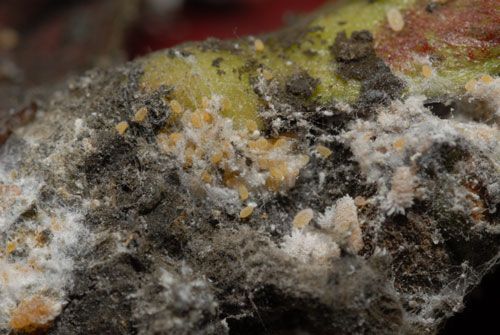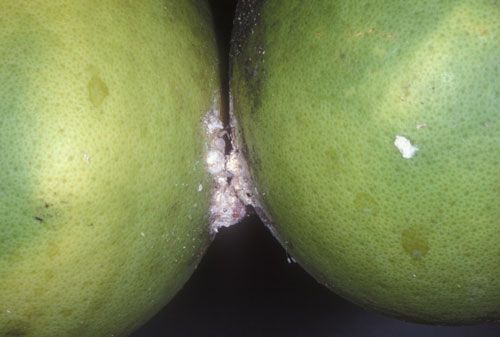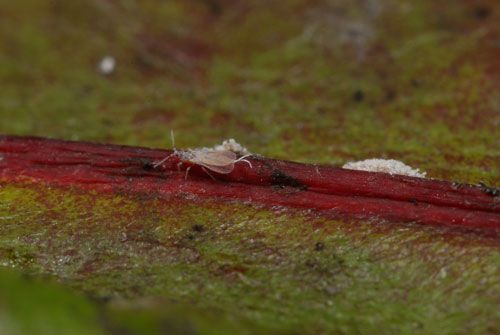The Featured Creatures collection provides in-depth profiles of insects, nematodes, arachnids and other organisms relevant to Florida. These profiles are intended for the use of interested laypersons with some knowledge of biology as well as academic audiences.
Introduction
The citrus mealybug is a common pest of citrus primarily in greenhouses and of several ornamental plants in Florida. It has been recognized as a difficult-to-control pest in Europe since 1813 (where it is called the greenhouse mealybug) and in the United States since 1879 (Anonymous 2007).
Distribution
The pest is a native of Asia but is also found throughout the Americas, Europe, and Oceania. In North America, it is present in both Mexico and the United States (Alabama, Arizona, Arkansas, California, Florida, Hawaii, Kansas, Louisiana, Maryland, Massachusetts, Missouri, New Mexico, Ohio, South Carolina, Tennessee, Texas, and Virginia) (CABI/EPPO 1999).
Description and Life History
Eggs
Eggs are deposited as white, cottony masses, called ovisacs, on the trunk and stems of citrus plants, giving the appearance of cotton spread on plants (Figure 1). The glossy, light yellow eggs are oval and approximately 0.3 mm long. A female can lay from 300 to 600 eggs in her life period, which are deposited in groups of five to 20. Depending on the season, egg hatch may occur after six to 10 days or several weeks. An average of 29 eggs per day is laid by females (Kerns et al. 2001, Meyers 1932).

Credit: Lyle Buss, University of Florida.
Immatures
Nymphs emerge from the ovisacs and typically settle along midribs and veins on the underside of leaves, young twigs, and fruit buttons. They can also be found where two fruits are touching each other (Figure 2) or on leaves clinging to fruits. Due to their habit of hiding in crevices, light infestations are easily overlooked. Wax and honeydew secreted by crawlers are visible indicators of infestations. First instar female and male nymphs are called crawlers. The nymphs take six to 10 weeks to reach maturity. The nymphs are yellow, oval-shaped with red eyes, and covered with white waxy particles (Griffiths and Thompson 1957). The female nymphs resemble the adult females (Kerns et al. 2001), while male nymphs are more elongated. Female nymphs have four instars. Males differ greatly; they have three instars and a pre-pupal stage. It is only the males that can produce a cottony-appearing cocoon and pupate (Anonymous 2007, Kerns et al. 2001). Male nymphs are narrower in appearance than females, and often occur in a loose cocoon (Anonymous 2007).

Credit: Lyle Buss, University of Florida.
Adults
Adult size ranges in length from 3 mm (females) to 4.5 mm (males). The females are wingless, white to light brown in color, with brown legs and antennae (Figure 3). The body of adult females is coated with white wax and bears a characteristic faint gray stripe along their dorsal side. Short waxy filaments can be seen around the margins of their oval body with a slightly longer pair of filaments present at the rear end of their body. Female mealybugs are wingless and, therefore, must be transported to subsequent host plants, although they are able to crawl for short distances. The immatures can be blown by wind. Females can live for up to 29 days depending on the host plant. Males are similar in color to females and have two long backward-projecting, white wax threads. Adult males are winged and thus capable of flying to new host plants for mating purposes (Anonymous 2007). Following emergence, males (Figure 4) live for one to two days during which they are incapable of feeding. Mealybugs remain motile throughout their life cycle, with the exception of the male pupa (Anonymous 2007, Griffiths and Thompson 1957, Polat et al. 2008).

Credit: Lyle Buss, University of Florida.

Credit: Lyle Buss, University of Florida.
Damage
Citrus mealybug feeding results in wilted, distorted, and yellowed chlorotic leaves, premature leaf drop, stunted growth, and occasional death of infested plants or plant parts. The sugary honeydew secreted by citrus mealybugs falls on leaves and fruits below, resulting in the growth of sooty mold. In addition to its unsightly appearance, sooty mold may degrade fruit quality by reducing the photosynthetic capacity of leaves (For more information on sooty mold, refer to Scale Insects and Mealybugs on Ornamental Plants).
Feeding under and adjacent to the button of oranges results in fruit drop, reducing crop yields. Oranges develop hard lumps as a result of mealybug feeding, resulting in discolored and poor quality fruit. Development of sooty mold on the fruit leads to commercially unacceptable appearance of fruits and requires vigorous scrubbing before packing the fruits. If not removed from the fruit after harvest, the remaining mealybugs continue to breed, causing loss during transit and storage (Griffiths and Thompson 1957).
Population Dynamics
Mealybugs are most common during the spring and early summer. Several overlapping generations occur in a year, but only one cycle (Spring–Summer) is of major concern to citrus growers in Florida, with peak infestations occurring in June or July. With the advent of the rainy season and warm weather, populations rapidly decline. In grapefruit groves, mealybugs persist in high numbers throughout the summer and into the fall. Reproduction in the greenhouse can occur year-round, leading to continuous populations of mealybugs (Griffiths and Thompson 1957).
Spread
Dispersal of citrus mealybugs may occur through active or passive modes. In addition to actively crawling between trees, the insects may be transported by wind, on birds' feet, or by machinery and labor crews (Kerns et al. 2001). In addition, ants get attracted by the honeydew released by mealybugs and, therefore, frequently carry them from one tree to another (Watson 1918).
Host Plants
Citrus mealybugs are primarily pests of citrus, but have been collected from at least 27 host plant families including indoor ornamentals, vegetables, and fruits. Grapefruit is preferred over other citrus varieties (Griffiths and Thompson 1957). Other host plants include Amaryllis sp. (Jersey lily), Ananas comosus (pineapple), Annona squamosa (sugar-apple), Asparagus sp., Begonia sp., Bougainvillea sp., Cactus sp., Canna sp. (canna lily), Citrus sp., Cocos nucifera (coconut), Solenostemon sp. (coleus), Codiaeum sp. (croton), Cucumis melo (muskmelon), Cucurbita sp., Cyclamen sp. (primrose or Persian violet), Cyperus sp. (flatsedge), Dahlia sp., Dioscorea sp. (yam), Euphorbia sp. (milkweed), Ficus sp. (fig trees or fig), Fragaria sp. (strawberries), Gardenia sp., Impatiens sp. (jewelweeds or touch-me-not), Ipomoea batatas (sweet potato), Mangifera indica (mango), Musa sp. (banana), Narcissus sp. (daffodil), Nicotiana sp., Oryza latifolia (grass), Persea americana (avocado), Phoenix dactylifera (date palm), Psidium guajava (guava), Punica granatum (pomegranate), Pyrus communis (pear), Pyrus malus (apple), Rosa sp., Solanum melongena (eggplant), Theobroma cacao (cacao), and Tulipa sp. (tulip) (Anonymous 2007, Martin and Mau 2007, McKenzie 1967). Jadhav et al. (1996) reported soybean as a host of citrus mealybug in India. Ahmed and Abd-Rabou (2010) reported that citrus mealybug infested 65 plant species belonging to 56 genera in Egypt.
Management
Citrus mealybug populations are naturally regulated by parasitic fungi and predacious insects. Summer rains cause mortality by washing the mealybugs from plants. Additional control measures may be necessary to reduce populations when infestations are large.
Chemical Control
Chemical control of citrus mealybugs is often an inefficient management strategy due to the mealybugs’ habit of hiding in crevices between foliage and fruit. High-pressure water sprays are moderately effective at achieving control. A powerful force pump and penetrating insecticide can be used to control mature insect populations. Repeated application of whale-oil soap, one pound in 2-3 gallons of water for young insects, has also been recommended (Hume 1954). Pre- and post-bloom spray applications are recommended for management of mealybugs. Applications made before spring flush have been found to be the most effective strategy for citrus mealybug management. After the spring flush, sprays should be applied immediately after most eggs have hatched to prevent crawlers from hiding themselves in crevices (Griffiths and Thompson 1957). Chemicals have been recommended for their control (For more information on chemical control, refer to Florida Citrus Pest Management Guide: Soft-Bodied Insects Attacking Foliage and Fruit).
Biological Control
Several natural enemies have been identified that are effective at controlling citrus mealybug. Leptomastidea abnormis (Girault), Leptomastix dactylopii Howard, Chrysoplatycerus splendens Howard, and Anagyrus pseudococci (Girault) are common wasp parasitoids of second and third instar nymphs (Anonymous 2007, Griffiths and Thompson 1957). Some insects are susceptible to infections by the entomopathogenic fungus Entomophthora fumosa (Speare 1922). Common predators include brown lacewing, Sympherobius barberi (Banks), and green lacewing, Chrysopa lateralis Guérin, trash bugs, syrphid fly larvae, and scale-eating caterpillars, Laetitia coccidivora (Watson 1918). Australian mealybug lady beetles, Cryptolaemus montrouzieri Mulsant, little mealybug-eating lady beetles, Decadiomus bahamicus (Casey), and pictured ladybeetles, Scymnus flavifrons Melsheimer, feed primarily on mealybugs. Two other lady beetles, Chilocorus stigma (Say) and Olla abdominalis var. plagiata (Say), occasionally feed on mealybugs (Muma 1954). In California, banding the trees with sticky tree-tangle foot or baiting for ants is recommended to protect citrus plants from Argentine ants that interfere with the activity of natural enemies (Davidson and Pearis 1956).
Cultural Measures
Historically in California, fumigation of picking sacks and boxes was recommended to prevent the spread of citrus mealybug (Woglum and Neuls 1917). Hedging citrus groves to reduce contact between trees and thorough cleaning of equipment and harvest materials were useful for reducing the spread of this insect in Arizona (Kerns et al. 2001). Because mealybugs may be more abundant on some ornamental hosts, growth of these plants near citrus groves should be avoided. These plants should be monitored and treated for infestations to prevent mealybug spread.
Selected References
Ahmed NH, Abd-Rabou SM. 2010. Host plants, geographical distribution, natural enemies and biological studies of the citrus mealybug, (Risso) (Hemiptera: Pseudococcidae). Egyptian Academic Journal of Biological Science 3: 39-47.
Anonymous (2007). Citrus mealybug. Center for Urban Ecology and Sustainability, University of Minnesota. (14 February 2019)
CABI/EPPO 1999. Planococcus citri. Distribution maps of plant pests no. 43. CAB International, Wallingford, UK.
Davidson RH, Pearis LM. 1956. Insect pests of farm, garden and orchard. 6th edition. John Wiley and Sons Inc., New York, USA.
Griffiths JT, Thompson WL. 1957. Insects and mites found on Florida citrus. University of Florida Agricultural Experiment Station Bulletin 591: 30-33.
Hume HH. 1954. The cultivation of citrus fruits. The Macmillan Company, New York, USA.
Jadhav RG, Madane NP, Kathamale, DK. 1996. Record of soybean as a new host in India for citrus mealybug. Insect Environment 2: 90.
Kerns D, Wright G, Loghry J. (2001). Citrus mealybug (Planococcus citri). College of Agriculture Cooperative Extension,University of Arizona. (14 February 2019)
Martin JL, Mau RFL. (2007). Crop knowledge master: Planococcus citri (Rizzo). EXTension ENTOmology & UH-CTAHR Integrated Pest Management Program. University of Hawaii (14 February 2019)
Meyers LE. 1932. Two economic greenhouse mealybugs of Mississippi. Journal of Economic Entomology 25: 891-896.
McKenzie HL. 1967. Mealybugs of California. University of California Press, Berkeley, USA. 525 pp.
Muma MH. 1954. Ladybeetle predators of mealybugs. Citrus Magazine 16: 16-17.
Polat F, Ulgenturk S, Kaydan MB. 2008. Developmental biology of citrus mealybug, (Risso), (Hemiptera: Pseudocccidae), on ornamental plants. pp. 177-184. In M. Branco, J.C. Franco, and C. Hodgson (eds.), Proceedings of the Xl international symposium on Scale Insect Studies, Lisbon, Portugal, 24-27 September 2007, Oeiras, Portugal. ISA Press, Lisbon, Portugal.
Speare AT. 1922. Natural control of the citrus mealybug in Florida. U.S. Department of Agriculture Bulletin 1117: 18.
Watson JR. 1918. Insects of a citrus grove. University of Florida Agricultural Experiment Station Bulletin 148: 214-216.
Woglum RS, Neuls JD. 1917. The common mealybug and its control in California. United States Department of Agriculture and Farmer's Bulletin 862: 16.